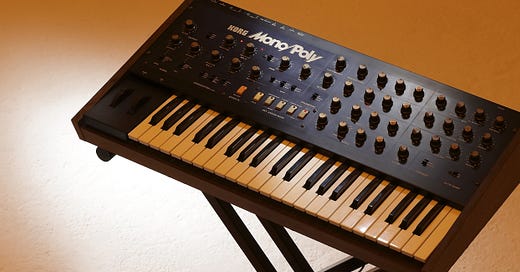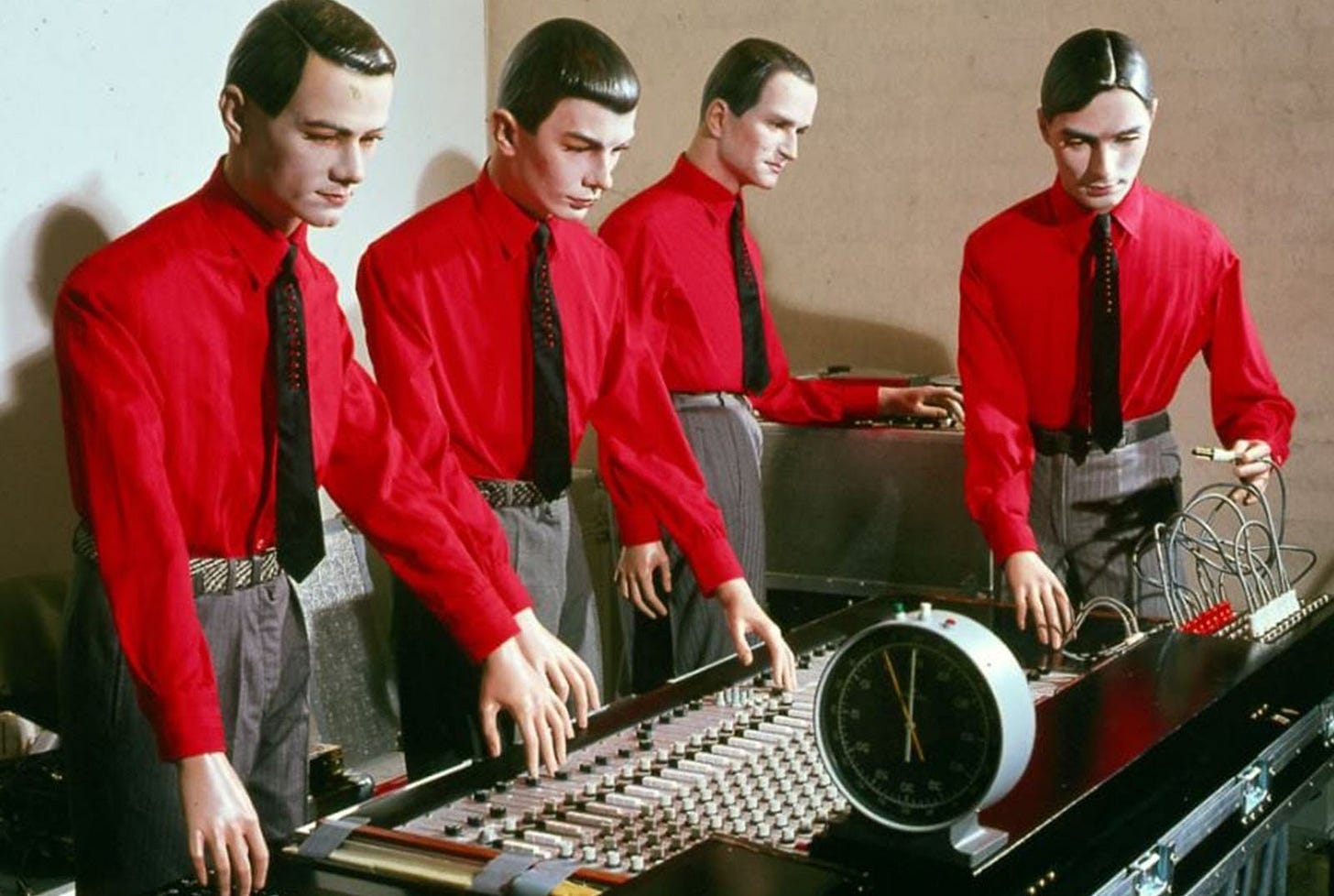Welcome back to One Take, a series that dissects great songwriting and production, one song at a time. Before we dive in, I wanted to share my recent conversation with the uber-talented
.We discuss neurodiversity, the music industry, our creative process and a host of other topics. Btw vōx’s fantastic new record ‘All My Best Friends Are Ghosts’ is out now. Be sure to check it out. :)
Last time, we talked about a song that arrived fully formed. This time, we’re looking at the perfect pop anthem: Robyn’s “Dancing On My Own.” As Simon Wu (whose great essay collection shares its name) put it:
There’s something about the feeling that it captures: being sad while dancing or being alone but with other people. Those two contradictions are just embedded in the way that the music sounds. Words fail to describe it, and then you listen to the song, and that’s what it feels like.
So, dare we attempt the impossible — and try to investigate why it feels the way it does?
One Take: ‘Stillettos on broken bottles’
Why does every songwriter write about heartbreak?
You’d think, after centuries of heartache refracted through ballads, sonnets, laments, and bangers, we’d run out of new ways to say I miss you or I can’t believe you left me for someone else or I’m fine without you, really — but we never do.
The breakup song is an inexhaustible genre, not because the basic plot points change (spoiler: they rarely do), but because every time it happens to you, you encounter the unique shape of loss. The specific pitch of the cathedral ceiling built to shelter you, that person, and the life lived or imagined — caving in on itself. You thought you knew heartbreak and then some reminder of them comes along — a street, a song, a scent — and it knocks the breath out of your windpipe. One time, I caught a whiff of Byredo Blanche on someone’s scarf (WTAF?) that sent me so hard back to an old flame, I needed to sit down. Every time you lose a connection (or did you lose it? did it just slip into some new shape?), it remakes the world a little.
Literature has long known this: The lover scorned is dramatic terra firma. See Taylor Swift’s entire catalog, the reigning architect of heartache, turning red scarves, getaway cars, and forgotten typewriters into a billion-dollar empire. But the empire isn’t our focus today. We’re breaking down one of the most perfect breakup anthems of all time.
What delineates the good breakup songs from the great ones?
It can’t just be catharsis. Plenty of songs vent. Plenty wallow. (I won’t say which of mine do both, but trust me — they’re there. Oh, to be that young again.) But the Dear John songs don’t have staying power for me. Spleen venting has a half-life. Unless you’re Fiona Apple. Spleen-vent away.
“I always try to write a song that I feel like maybe Prince could like.” - Robyn
Robyn enters the floor
“Dancing On My Own” was released in 2010 into a pop universe dominated by the maximalist escapism of Kesha’s “Tik Tok” and Katy Perry’s “California Gurls” (even I had to double check that spelling was not a typo). Basically, the party was the cure for what ails you. Pop’s dominant flavor told you to drink, forget, and throw glitter at the problem. Robyn walked into that same party and said: Nah, I’m good. I’ll be right in the corner, watching you kiss her.
In her Red Bull Music Academy Lecture, she shared:
I wanted to write music that was about the things I was going through, but still make people dance.
If you’re a millennial, odds are you remember exactly where you were when you first heard this song. It’s of its time — like that scene in Girls, skinny jeans, One Direction forming on X Factor — but it’s also timeless. It belongs to the pantheon of queer anthems like Gloria Gaynor’s ‘I Will Survive,’ or Lady Gaga’s ‘Born This Way.’
And at the center of it all, a gleaming arpeggio that rises up and up to the rafters. A storm in a chrome teacup.
Finding the right harmonic secret sauce
Time to nerd out a little.
Even though the lyrical theme is heartbreak, the song is in a major key — G♭ major — not minor. One of my favorite keys to write in, because it has a darkness, yes, but it’s like a a shimmering, caramel-colored darkness. (Or at least that’s how it sounds to my synaesthetic brain.) It doesn’t get bogged down easily. If you pump up the production value with brighter/cooler elements, it’s less likely to get bogged down.
At its center is that fatty Korg Mono/Poly synth, arpeggiating this four-chord loop and articulating the bass note:
G♭ → D♭ → E♭m → C♭
This is the classic I–V–vi–IV pop progression — one of the most emotionally effective cycles in popular music. Why?
The I chord (G♭ major) gives us a sense of home and stability. Having it in a darker major key like this establishes the song’s emotional center, but gives it an openness. A little like … dancing in the center of a darkened club.
The V chord (D♭ major) gives lift. The F inside it wants to resolve to G♭ — tension built right in.
The vi chord (E♭ minor) introduces our shade. That’s a good thing. The memory creeping back. Tells us this isn’t “good vibes only.”
The IV chord (C♭ major) smooths the edges before looping back to I. Makes the drop back to the I feel more satisfying.
What’s cool about the original’s progression is that the song never resolves in a dramatic way. Verse and chorus — the progression remains the same.
This loop circles back. You have the bass line, articulating the progression with 16th notes — which is then reinforced on the choruses by a higher, G♭ pulsing at the same 16th note rate like an EKG. In this song, that 16th note replaces what a hi-hat might typically (there are some hi-hat flourishes in the choruses but they remain low and restrained). I love this move, because it’s so rich and harmonic, it enables the mix to stay relatively roomy.
Even more important, that high G♭ creates a suspension that’s critical to sustaining the tension that gives the song its staying power. It gives contrast between the major key and the gut-punch of the lyrics — that is where the magic lives.
Even the bridge (So far away, but still so near…) resists the typical pop song pivot. Instead of offering a big lift, it shifts the emotional temperature just slightly:
B♭ minor – E♭ minor – B♭ minor – E♭ minor – G♭ – D♭ – G♭
With the kick and snare stepped out until the 3:07 mark, this back-and-forth between B♭m and E♭m acts as emotional suspension, like holding a breath. But instead of modulating to a new key or tweaking the progression, we revert back to the original progression where we stay until the end. We’re stuck. Or are we? Staying in the feeling a little longer is a choice, too.
If you want to write using a progression like this, the key you pick matters. Compare Calum Scott’s cover, which moves into C♯ major and strips everything down to a piano ballad. His version feels distant, cool, soliloquy-like. Robyn’s original is a sparkly bop. All it takes is a few degrees of key and production shifting to change the emotional weather.
Stockholm Sound: Fembots have feelings too
But the chords aren’t the only thing driving the song forward.That classic four-on-the-floor kick sticks to your ribs. Steady, mechanical. Not bombastic. The snare? Gated, plasticky, clipped. Not big. Not warm. Sounds kind of smooshed.
Compare this with a big pop snare like the one found in “I Wanna Dance With Somebody.”
“Dancing On My Own”’s snare is way more contained. A little robotic.
This is no accident. Robyn’s Body Talk era explored the intersection of body and machine, a world where Fembots had feelings, too. The dance floor as the site where flesh meets metal, and all the body’s incongruities rise to the surface. And she wasn’t the only one thinking about our AI-powered future. Janelle Monae’s Cindi Mayweather alter ego made her debut just a month after this song’s release on The ArchAndroid in May of 2010, which feels even more prescient to listen to now. Like if Octavia Butler made a pop album.
Kraftwerk gets namechecked first when we talk about the cool precision of early-2000s Swedish pop, but the kick and snare? That’s pure Detroit techno and Chicago house. The soul-synthetic hybrids of the '80s and '90s were already in Stockholm’s air by the time Robyn was a teen, and it’s worth remembering that Barry Gordy’s Motown helped influence Kraftwerk’s sound, too. On Detroit’s WGPR-FM, thanks to DJ the Electrifying Mojo, Kraftwerk first made inroads overseas in the late 70s. Mojo’s genre-agnostic playlists could veer from The Robots to Prince’s I Wanna Be Your Lover and the B-52’s Rock Lobster all in one night. One of his most devoted listeners was Juan Atkins, who would go on to form Cybotron and release music as Model 500, pioneering techno alongside the Belleville Three — “envisioning the future from a Motor City perspective,” as Marcus Barnes puts it.
Listen for that distinctive, high-pitched ping that ricochets around the beat? I hear that and think immediately of the icy synth tones in Atkins’ Clear, later sampled by Missy Elliott in Lose Control.
Max Martin, Patrik Berger (who produced “Dancing On My Own”), and many others built their sound inside the grid the Belleville Three laid down. Pop sounds the way it does today in no small part because of them.
The vocal holds it all together
If the beat is all machine, Robyn’s delivery serves as human counterpoint.
Lyrically, the premise is bare-bones: Girl shows up to the club, sees her ex kiss someone else, stays anyway. That’s it.
I’m in the corner, watching you kiss her.
But those eight words build an entire emotional architecture. We don’t need any further context or flashback to get it. It locks us into the drama, while the melody does the heavy lifting.
Robyn leans hard on the leading tone — an F. When she sings “Yeah, I know it’s stupid, just gotta see it for myself”, observe how she bounces between the G♭ and that F. It’s the note that just wants to go home — and won't. Just like the nararrator.
“Usually when I write music it starts with melody and rhythm... it won’t be actual words. They’ll just be like a rhythm mostly with some notes. And sometimes it’s lyrics. Sometimes it’s just the words that I love,” Robyn said in her Red Bull Music Academy lecture. “With ‘Dancing On My Own,’ the melody and the rhythm and some of the words kind of came at the same time. But a lot of it started with gibberish — what we call yogurt.”
Yogurt or not, in an early demo, you can hear that most of the song elements came together early. The basic chord structure, the 16th note motif, and chorus lyrics popped up around the same time. The bones of the song — it’s emotional DNA — actually come through in the gibberish. When you’re writing, don’t be afraid to use it. I say “badabeeba” or “banana” or whatever a lot in my own demos.
The chorus is where that tension finally blooms. The melody rises across the third, second, and tonic scale degrees, giving it that pleading, restless feeling. It resists closure the same way the narrator resists leaving the club. She knows what she’ll see there will let her down, and chooses to look anyway.
I’m in the corner / watching you kiss her / ohhhhhh…
Melodically, it’s more of a spiral than a leap. The vocal line hovers just above the tonic, never quite letting loose until she sings “I’m giving it my all.” The lift comes not from the voice, but from the synths rising underneath it.
I’m right over here / why can’t you see me? / ohhhhhh…
That long, open “ohhh” is my favorite — it suspends the clock and makes the payload of the drum fill feel more satisfying. A single vowel stretched out in time can sometimes say more than actual words. It’s sonic equivalent of a facepalm. Don’t you just see her being like “girl, what the fuck were you thinking?” as the line descends?
When Robyn showed up to the session she wanted anything but a bunch of synths and electronic beats in front of her. So they wrote an acoustic version of the song instead. Says Berger:
“We wanted to find that bittersweet emotion of actually making the feeling it feels like if you’re being left by somebody, not trying to act like you’re strong and ‘I’m gonna move on and I’m too good for you,’ that kind of crap,” says Berger. “It was more about, ‘It feels like s–t and I’m not gonna be the best person now. I’m just gonna be miserable…’ You can’t stop yourself.”
It reminds me a little of this Sharon Olds poem, The Flurry:
We are so together, so concentrated.
I mutter, “I feel like a killer.” “I’m
the killer” — taking my wrist — he says,
holding it. He is sitting on the couch,
the old indigo chintz around him,
rich as a night sea with jellies,
I am sitting on the floor. I look up at him,
as if within some chamber of matedness,
some dust I carry around me.
See how she yokes the narrarator to her soon-to-be ex. It’s all there, in 9 lines. The past (their marriage), the present (ruptured beyond repair), and future (a separation). Notice how claustrophobic the lines are. Even in the process of detangling, she physically links them. His hand on her wrist. It’s uncomfortable to read. But Olds never narrates away the pain. Neither does Robyn. Her narrator doesn’t leave the club or storm out. Surrounded by stilettos on broken bottles, spinning ‘round in circles. By staying, she enlarges the discomfort until it becomes something luminous.
Most poignantly, I think, is that both the poem and this song encapsulate how bound up in one another people can get — right before or even after parting ways. Olds allow this moment stretch out for the length of the poem. Robyn sustains it for the entire song. To veer into personal triumph would ring hollow here. Too soon for it.
Why does it work?
It’s a gesture we rarely see in pop: no arc, no girl gets girl back. The song ends the way it began — alone in a room full of people, watching. Since then, we’ve seen countless other pop queens take this baton and run with it. Lorde’s ‘Green Light.’ MUNA’s ‘Stayaway.’ Even Ms. Swift. But ‘Dancing On My Own’ has a simplicity those songs lack that takes it into the realm of the universal and timeless.
Over the years, especially post-pandemic, it’s taken on new significance for me.
How many nights have I stood sweating on a dance floor and looked over to see someone crying quietly beside me? How many nights in my life have I been that person? Who amongst us hasn’t put our heart in a splint and kept moving anyway — not to forget, for how could you forget? But to get to the other side.
The breakup songs I return to — even when I’m not actively heartbroken — almost always render this tricky emotional contradiction legible. They hold the ambivalence, the stubbornness, the cringe, the parts that don’t fit neatly into an empowerment arc. They let you sit inside what won’t resolve — what may never resolve.
That’s why we keep writing them. And why we keep needing them. Not to learn something new, per se, but to feel less alone in the absurd, hyper-specific grief of leaving or being left behind. It may not lift you out of your body. It can’t tell you it’ll all be ok in the morning. But it can offer some presence. Clear-eyed and, sure — a little messy.
Still dancing. Still wrecked. Still here.
xo
CD
If you liked this issue…
I’d love to hear from you. I read every message people send.
And if you haven’t already done so, please consider subscribing. Not only will you get every issue delivered right to your inbox, but it helps support more writing like this.








